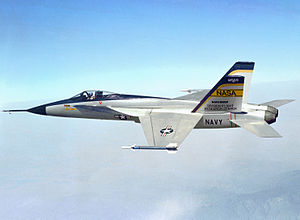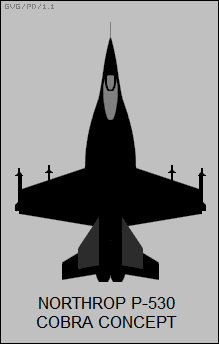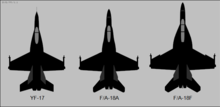avia.wikisort.org - Aeroplane
The Northrop YF-17 (nicknamed "Cobra") is a prototype lightweight fighter aircraft designed by Northrop aviation for the United States Air Force's Lightweight Fighter (LWF) technology evaluation program. The LWF was initiated because many in the fighter community believed that aircraft like the F-15 Eagle were too large and expensive for many combat roles. The YF-17 was the culmination of a long line of Northrop designs, beginning with the N-102 Fang in 1956, continuing through the F-5 family.
| YF-17 "Cobra" | |
|---|---|
 | |
| YF-17 in 1976 during a demonstration flight | |
| Role | Prototype fighter aircraft |
| National origin | United States |
| Manufacturer | Northrop |
| First flight | 9 June 1974 |
| Status | Retired |
| Primary user | United States Air Force (intended) |
| Number built | 2 |
| Developed into | McDonnell Douglas F/A-18 Hornet |
Although it lost the LWF competition to the F-16 Fighting Falcon, the YF-17 was selected for the new Naval Fighter Attack Experimental (VFAX) program. In enlarged form, the F/A-18 Hornet was adopted by the United States Navy and United States Marine Corps to replace the A-7 Corsair II and F-4 Phantom II, complementing the more expensive F-14 Tomcat.[1] This design, conceived as a small and lightweight fighter, was scaled up to the Boeing F/A-18E/F Super Hornet, which is similar in size to the F-15 and ultimately replaced the F-14.
Design and development

Background
The aircraft's main design elements date to early 1965, from the internal Northrop project N-300. The N-300 was derived from the F-5E, and features a longer fuselage, small leading-edge root extensions (LERX), and more powerful GE15-J1A1 turbojets, rated at 9,000 lbf (40 kN). The wing position was raised slightly to increase ground clearance for ordnance. The N-300 further evolved into the P-530 Cobra, which uses 13,000 lbf (58 kN) GE15-J1A5 engines, with a very small .25 bypass ratio leading to the nickname "leaky turbojet". The bypass air was required for cooling the afterburner and nozzle and the cool bypass duct surface allowed the engine bay to be constructed of lighter, cheaper materials.[1]
The P-530 wing planform and nose section were similar to the F-5, with a trapezoidal shape formed by a sweep of 20° at the quarter-chord line, and a tapered trailing edge, but was over double the area, with 400 sq ft (37 m2) as opposed to 186 sq ft (17.3 m2) of the F-5E. Initially shoulder mounted, the wings were lowered to the mid position. Its most distinctive new feature were the LERXs that tapered into the fuselage under the cockpit. They enabled maneuvering at angles of attack exceeding 50°, by providing about 50% additional lift. The extensions also align airflow into the engines at high angles of attack. The resemblance to the head of a cobra lead to the adoption of the nickname "Cobra", often unofficially used for the YF-17.[2]
Lightweight Fighter program

When the Lightweight Fighter program was announced in 1971, Northrop modified the P-530 into the P-600 design that would be designated YF-17A. Whereas the P-530 was intended as a multi-role aircraft, the P-600 was to be strictly an air-to-air demonstrator, and consequently the cannon moved from the underside of the fuselage, to the upper part. Design of the YF-17 and the prototype YJ101 engine, a development of the GE15 engine, consumed over a million man-hours, and 5,000 hours of wind tunnel testing.
The YF-17 was primarily constructed of aluminum, in conventional semi-monocoque stressed-skin construction, though over 900 lb (408 kg) of its structure were graphite/epoxy composite. The small nose contained a simple ranging-radar. The cockpit had an ejection seat inclined at 18°, a bubble canopy, and a head-up display (HUD). The thin wings carried no fuel, and in areas such as the leading and trailing edge and the LERX, were composed of a Nomex honeycomb core with composite facesheets. The rear of the aircraft had twin all-moving stabilators of aluminum over a honeycomb core, and twin vertical stabilizers of a conventional construction. Like the wings, the leading and trailing edges were constructed of composite facesheets over honeycomb core. A composite speedbrake was located on top of the fuselage between the engines.[3]
The aircraft was powered by two 14,400-pound-force (64 kN) General Electric YJ101-GE-100 afterburning turbojets,[4] installed next to each other to minimize thrust asymmetry in the event of an engine failure. To minimise engine removal time they were removed from below the aircraft without disturbing the empennage controls. Each engine drove an hydraulic pump for independent aircraft systems. Unlike the P-530, the YF-17 had partial fly-by-wire, called an electronic control augmentation system (ECAS), which used ailerons, rudders, and stabilators for primary flight control.[3]

Studies showed a single vertical stabilizer was insufficient at high angles of attack, and it was changed to twin vertical stabilizers, canted at 45°, resulting in a "relaxed longitudinal stability" design, which enhances maneuverability. Northrop was not yet confident in fly-by-wire controls and retained mechanically-actuated flight controls. The resulting aircraft, unveiled on 28 January 1971, had a maximum weight of 40,000 lb (18,144 kg) and maximum speed of Mach 2, but stirred little interest among foreign buyers.[2]
The first prototype (serial number 72-1569) was rolled out at Hawthorne on 4 April 1974; its first flight at Edwards AFB came on 9 June with Henry "Hank" Chouteau at the controls[5] flying for 61 minutes reaching an altitude of 18,000 feet and a maximum speed of 610 miles per hour.[6] Chouteau afterwards remarked that, "When our designers said that in the YF-17 they were going to give the airplane back to the pilot, they meant it. It's a fighter pilot's fighter."[6] The second YF-17 (s/n 72-1570) first flew on 21 August.[5] Through 1974, the YF-17 competed against the General Dynamics YF-16. The two YF-17 prototypes flew 288 test flights, totaling 345.5 hours.[5] The YF-17 attained a top speed of Mach 1.95, a peak load factor of 9.4 g, and a maximum altitude of over 50,000 ft (15,000 m). It demonstrated a maximum angle of attack of 68 degrees at 28 kn IAS.[7]
Naval Fighter Attack Experimental
Initially, the U.S. Navy was not heavily involved as a participant in the LWF program. In August 1974, Congress directed the Navy to make maximum use of the technology and hardware of the LWF for its new lightweight strike fighter, the VFAX.[8] As neither contractor had experience with naval fighters, they sought partners to provide that expertise. General Dynamics teamed with Vought for the Vought Model 1600; Northrop with McDonnell Douglas for the F-18. Each submitted revised designs in line with the Navy needs for a long-range radar and multirole capabilities.[9]
Flight testing
Prototype YF-17 72-1569 was sent to NASA's Dryden Research Center for base drag studies from 27 May to 14 July 1976 prior to the first F/A-18 prototype under development.[10]
Aircraft on display

- YF-17
- 72-1569 – Western Museum of Flight in Torrance, California[11]
- 72-1570 – Battleship Memorial Park in Mobile, Alabama[12]
Specifications (YF-17A)

Data from Northrop YF-17: The fighter they didn't want[13]
General characteristics
- Crew: 1
- Length: 55 ft 6 in (16.92 m)
- Wingspan: 35 ft 0 in (10.67 m)
- Height: 14 ft 6 in (4.42 m)
- Wing area: 350 sq ft (33 m2)
- Empty weight: 21,000 lb (9,525 kg)
- Gross weight: 23,000 lb (10,433 kg)
- Max takeoff weight: 30,630 lb (13,894 kg)
- Powerplant: 2 × General Electric YJ101-GE-100 turbojet, 14,400 lbf (64 kN) thrust each (with reheat)
Performance
- Maximum speed: 1,320 mph (2,120 km/h, 1,150 kn) at 40,000 feet (12,000 m)
- Range: 2,800 mi (4,500 km, 2,400 nmi)
- Service ceiling: 60,000 ft (18,000 m)
Armament
- Guns: 1× 20 mm (0.79 in) M61 Vulcan Gatling gun
- Missiles: 2× AIM-9 Sidewinder
See also
- List of military aircraft of the United States
- List of fighter aircraft
Related development
Aircraft of comparable role, configuration, and era
References
Notes
- Jenkins, Dennis R. F/A-18 Hornet: A Navy Success Story. New York: McGraw-Hill, 2000. ISBN 0-07-140037-0.
- Baugher, Joe. "Northrop YF-17 Cobra", 20 July 2009. Retrieved: 4 August 2010.
- Winchester 2005. p. 191.
- Jane's All The World's Aircraft 1975-76< ISBN 0 531 03250 7, p.748
- Jenkins and Landis 2008, p. 228.
- Simonsen, Erik. "Legacy of the Lightweight Fighter Competition" (PDF). Air Force (magazine). Arlington, Virginia: Air Force Association. 100 (2): 62. ISSN 0730-6784. OCLC 5169825.
- Flight International, 2 December 1978, p.2023
- Miller 1986, p. 5.
- Wooldridge, E.T., ed. with John S. McCain. Into the Jet Age: Conflict and Change in Naval Aviation, 1945–1975: An Oral History. Annapolis, Maryland: Naval Institute Press, 1995. ISBN 1-55750-932-8.
- "YF-17 Cobra Photo Collection." NASA Dryden Photo Collection. Retrieved: 4 August 2010.
- "YF-17 Cobra/Prototype #1." Western Museum of Flight via wmof.com
- "YF-17 Cobra/Prototype #2." Archived 4 September 2012 at the Wayback Machine USS Alabama park via USSAlabama.com
- Gunston 1995, p. 40.
Bibliography
- Gunston, Bill. "Northrop YF-17: The fighter they didn't want". Wings of Fame, Volume 1, 1995. London: Aerospace Publishing. pp. 34–47. ISSN 1361-2034 ISBN 1-874023-68-9.
- Jenkins, Dennis R. and Tony R. Landis. Experimental & Prototype U.S. Air Force Jet Fighters. North Branch, Minnesota, USA: Specialty Press, 2008. ISBN 978-1-58007-111-6.
- Miller, Jay. McDonnell Douglas F/A-18 Hornet (Aerofax Mingraph 25). Arlington, Texas, USA: Aerofax, 1986. ISBN 0-942548-39-6.
- Wilson, Stewart. Phantom, Hornet and Skyhawk in Australian Service. Weston Creek, Australia: Aerospace Publications, 1993. ISBN 1-875671-03-X.
- Winchester, Jim. "Northrop YF-17". Concept Aircraft: Prototypes, X-Planes and Experimental Aircraft. Kent, UK: Grange Books, 2005. ISBN 978-1-84013-809-2.
External links
На других языках
[de] Northrop YF-17
Die Northrop YF-17 Cobra war ein Prototyp im Rahmen des Lightweight-Fighter-Programms (LWF) der U.S. Air Force. Dieses wurde initiiert, da man der Meinung war, dass die F-15 Eagle zu teuer sei, um sie in ausreichenden Stückzahlen produzieren zu können. Allerdings spielten auch wirtschaftspolitische Interessen eine Rolle, besonders in Bezug auf den Exportmarkt. Die YF-17, bei der es sich im weitesten Sinne um eine Weiterentwicklung der F-5 handelt, unterlag im LWF-Programm ihrer Konkurrentin, der YF-16.- [en] Northrop YF-17
[fr] Northrop YF-17 Cobra
Le Northrop YF-17 est un prototype d'avion de chasse construit à deux exemplaires dans le cadre du programme américain Light Weight Fighter. Candidat malheureux à cette compétition, il a malgré tout été retenu par l'US Navy et a donné naissance au F/A-18 Hornet.[it] Northrop YF-17 Cobra
Il Northrop YF-17A Cobra era un prototipo di aereo da caccia realizzato per partecipare al concorso indetto dall'USAF per la specifica "Lightweight Fighter" (caccia leggero), vinto poi dall'YF-16 durante la "Fly-off Competition". Nonostante le buone qualità, la Northrop non riuscì a dimostrare che un bimotore, certamente più costoso, fosse nettamente più affidabile di un monomotore, e così alla fine vinse l'F-16. Quando il concorso per il LWF fu vinto dall'F-16, la Marina degli Stati Uniti d'America preferì prendere in considerazione il perdente Northrop YF-17. Tuttavia questa scelta comportò dei problemi: il prototipo era troppo piccolo pur essendo bimotore (infatti, all'epoca si riteneva che gli aerei imbarcati dovessero avere due motori per maggiore sicurezza) e la Northrop non aveva abbastanza esperienza nella costruzione di aerei imbarcati. La Northrop quindi si alleò con la McDonnell Douglas, che aveva maggiore esperienza e godeva di maggiore prestigio nella costruzione di aerei per la US Navy (come l'F-4 Phantom II), e sviluppò due prototipi diversi: l'F-18 da caccia e l'A-18 da attacco. In seguito a problemi logistici i due progetti furono fusi in un unico aeroplano che prese la denominazione di F/A-18. Il progetto dell'YF-17 passò così di mano alla McDonnell Douglas, che prese il 60% del programma, da cui sviluppò l'F/A-18 Hornet: a quel punto la Northrop era ridotta a poco più che una subcontraente.[ru] Northrop YF-17 Cobra
Нортроп YF-17 Кобра (англ. Northrop YF-17 Cobra) — многоцелевой истребитель. Был истребителем лёгкого веса, разработанным для ВВС США в рамках программы LWF. Проект YF-17 был создан с целью заменить такой истребитель как F-15 Eagle, который считался очень большим и тяжелым.Другой контент может иметь иную лицензию. Перед использованием материалов сайта WikiSort.org внимательно изучите правила лицензирования конкретных элементов наполнения сайта.
WikiSort.org - проект по пересортировке и дополнению контента Википедии